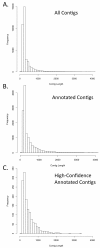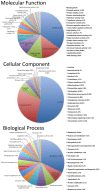A multi-organ transcriptome resource for the Burmese Python (Python molurus bivittatus)
- PMID: 21867488
- PMCID: PMC3173347
- DOI: 10.1186/1756-0500-4-310
A multi-organ transcriptome resource for the Burmese Python (Python molurus bivittatus)
Abstract
Background: Snakes provide a unique vertebrate system for studying a diversity of extreme adaptations, including those related to development, metabolism, physiology, and venom. Despite their importance as research models, genomic resources for snakes are few. Among snakes, the Burmese python is the premier model for studying extremes of metabolic fluctuation and physiological remodelling. In this species, the consumption of large infrequent meals can induce a 40-fold increase in metabolic rate and more than a doubling in size of some organs. To provide a foundation for research utilizing the python, our aim was to assemble and annotate a transcriptome reference from the heart and liver. To accomplish this aim, we used the 454-FLX sequencing platform to collect sequence data from multiple cDNA libraries.
Results: We collected nearly 1 million 454 sequence reads, and assembled these into 37,245 contigs with a combined length of 13,409,006 bp. To identify known genes, these contigs were compared to chicken and lizard gene sets, and to all Genbank sequences. A total of 13,286 of these contigs were annotated based on similarity to known genes or Genbank sequences. We used gene ontology (GO) assignments to characterize the types of genes in this transcriptome resource. The raw data, transcript contig assembly, and transcript annotations are made available online for use by the broader research community.
Conclusion: These data should facilitate future studies using pythons and snakes in general, helping to further contribute to the utilization of snakes as a model evolutionary and physiological system. This sequence collection represents a major genomic resource for the Burmese python, and the large number of transcript sequences characterized should contribute to future research in this and other snake species.
Figures




Similar articles
-
The Burmese python genome reveals the molecular basis for extreme adaptation in snakes.Proc Natl Acad Sci U S A. 2013 Dec 17;110(51):20645-50. doi: 10.1073/pnas.1314475110. Epub 2013 Dec 2. Proc Natl Acad Sci U S A. 2013. PMID: 24297902 Free PMC article.
-
Sequencing the genome of the Burmese python (Python molurus bivittatus) as a model for studying extreme adaptations in snakes.Genome Biol. 2011 Jul 28;12(7):406. doi: 10.1186/gb-2011-12-7-406. Genome Biol. 2011. PMID: 21801464 Free PMC article.
-
Selected regulation of gastrointestinal acid-base secretion and tissue metabolism for the diamondback water snake and Burmese python.J Exp Biol. 2012 Jan 1;215(Pt 1):185-96. doi: 10.1242/jeb.056218. J Exp Biol. 2012. PMID: 22162867
-
Utility of the burmese Python as a model for studying plasticity of extreme physiological systems.J Muscle Res Cell Motil. 2023 Jun;44(2):95-106. doi: 10.1007/s10974-022-09632-2. Epub 2022 Nov 1. J Muscle Res Cell Motil. 2023. PMID: 36316565 Free PMC article. Review.
-
Ecological correlates of invasion impact for Burmese pythons in Florida.Integr Zool. 2012 Sep;7(3):254-270. doi: 10.1111/j.1749-4877.2012.00304.x. Integr Zool. 2012. PMID: 22938523 Review.
Cited by
-
Reptilian Transcriptomes v2.0: An Extensive Resource for Sauropsida Genomics and Transcriptomics.Genome Biol Evol. 2015 Jul 1;7(6):1827-41. doi: 10.1093/gbe/evv106. Genome Biol Evol. 2015. PMID: 26133641 Free PMC article.
-
Transcriptome analysis of the response of Burmese python to digestion.Gigascience. 2017 Aug 1;6(8):1-18. doi: 10.1093/gigascience/gix057. Gigascience. 2017. PMID: 28873961 Free PMC article.
-
Phylogenomic analyses support the position of turtles as the sister group of birds and crocodiles (Archosauria).BMC Biol. 2012 Jul 27;10:65. doi: 10.1186/1741-7007-10-65. BMC Biol. 2012. PMID: 22839781 Free PMC article.
-
Rapid changes in gene expression direct rapid shifts in intestinal form and function in the Burmese python after feeding.Physiol Genomics. 2015 May;47(5):147-57. doi: 10.1152/physiolgenomics.00131.2014. Epub 2015 Feb 10. Physiol Genomics. 2015. PMID: 25670730 Free PMC article.
-
The first Chameleon transcriptome: comparative genomic analysis of the OXPHOS system reveals loss of COX8 in Iguanian lizards.Genome Biol Evol. 2013;5(10):1792-9. doi: 10.1093/gbe/evt131. Genome Biol Evol. 2013. PMID: 24009133 Free PMC article.
References
-
- Ott BD, Secor SM. Adaptive regulation of digestive performance in the genus Python. J Exper Biol. 2007;210(Pt 2):340–356. - PubMed
LinkOut - more resources
Full Text Sources

